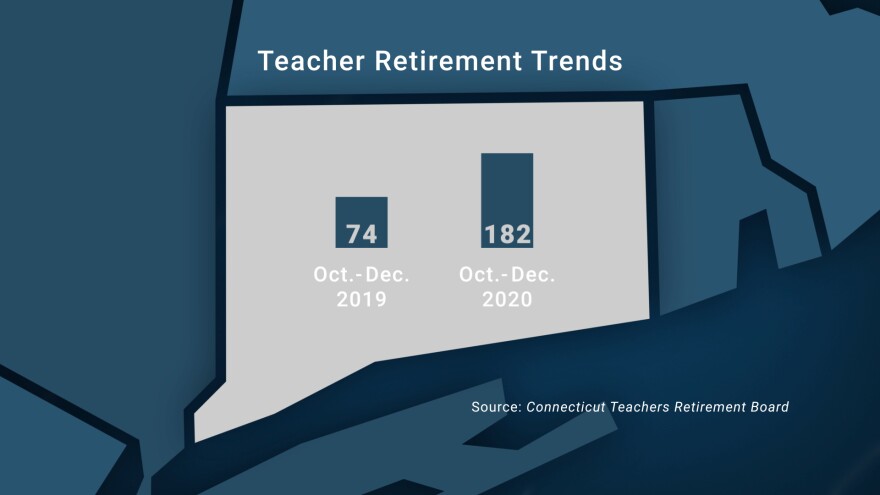As the pandemic stretches through another school year, there are several ways to evaluate how the public health crisis is impacting students and educators.
By several measures, things are not going well for many.
On Thursday at 8 p.m., Connecticut Public will share their stories during a one-hour show on CPTV. This episode of CUTLINE takes a deep dive into how the public health emergency is reshaping education.
Here are five big takeaways:
Mixed feelings/research about whether school is safe as COVID surges
The state releases data each week on how many students and staff have tested positive for the virus. Parents can see how many infections there have been in their kids' school here.
While the data looks scary — nearly 13,000 students infected in one week — it does not include how many students were tested during that time, so it's unclear what the infection rate is.
Public health experts have said throughout the pandemic that high rates of people testing positive suggest that the virus is spreading in the community and that there are likely more people with the virus who haven’t been tested yet.
Regardless, Gov. Ned Lamont has insisted that schools are healthy and safe.
"We're keeping the schools open. I think we can do it safely," he said during a sit-down interview for Cutline. "I think we have the therapies. I know we're going to have the testing. I know we're moving the vaccination mobile vans to the schools, [and] make it available with parental supervision or parental authorization. We can keep our schools open safely."
So does keeping schools open contribute to COVID further spreading in the community?
A Dec. 15 brief from the Centers for Disease Control and Prevention notes that assessing whether schools are safe is complex because of different mitigation approaches by districts and other changing variables.
"We're keeping the schools open. I think we can do it safely.Gov. Ned Lamont (D)
Connecticut teachers also have mixed views about whether they feel safe.
Tiffany Moyer-Washington, an English teacher at Hartford Magnet Trinity College Academy, said vaccinations have helped.
"I feel safer than I did prior to that, but our numbers are going up," she said of the growing number of educators getting COVID. "If my colleague is out, well, then I'm also covering their class. So I think coverage is something that causes a stressor, not just [because] you have to give up your prep time, but you're also exposing yourself to another group of 20 kids or 30 kids."
She also said her classroom doesn't have the space for her 28 students to distance themselves. Last year, she had 14 students.
"I'd like to say I feel safe, but I think I could feel safer," she said. "You can keep 14 kids apart. You cannot keep 28 high school kids apart. In my creative writing class, they're adult-size humans — and so I think that that's hard. As much as I wish I could say everybody feels safe, I don't think that that's the case."
Gwen Crosby feels safe.
"For me, I know how to protect myself and I feel calm and comfortable listening to the CDC ... I feel perfectly safe being in the building," said Crosby, an English teacher at CREC Academy of Computer Science & Engineering Middle School. "Being out of school was painful. There were children I taught last year that I wouldn't know them if I passed them on the street. They were little black boxes with their names underneath. That's not what I do for a living. I need to look at them. I need to see how they are in the morning and I need to help them through the tricky parts."
Many children are struggling

School-age children may not be dying from COVID, but their parents or grandparents are.
At least 1,000 Connecticut children lost their primary guardian to COVID through last June, according to research conducted by CDC staff and published by the American Academy of Pediatrics.
The aftermath of this and the other pandemic-related traumas students are facing is showing up at school.
"I've had more kids who are on suicide watch, or who have started doing self-harming with cutting, or things like that — more than I've ever seen before," said Moyer-Washington. "When I grew up, there was no worry of like some monster that was gonna come kill you. There's this invisible monster that's taking people away. I think that's a real weight that's weighing on kids."
Crosby is seeing her students struggle, too.
"Sometimes the behaviors that we see are a reaction to, 'I have all these feelings and I don't know what to do with it,'" she said. "And sometimes a simple redirect — 'Please take your seat' — can become explosive or aggressive."
The state Department of Education surveys school districts every year to take a pulse of the physical and mental health of students — and how things are going.
The last survey released was completed in the early months of the pandemic and measured student health for the 2019-20 school year.
The responses were grim.
- "Mental health seems to be growing and support dwindling."
- "911 calls for psychosocial emotional issues; students’ behavior unsafe to self and others."
- "We send them to our [emergency department] or call 211 but find they return rapidly with not much done to address the underlying issues."
- "Since the outbreak of COVID-19, the children are living in fear of not having a parent at home or not returning from the hospital."
During the 2019-20 school year, just over 10,000 students had been diagnosed with anxiety and nearly 4,700 with depression.
While these numbers align with the number of students facing behavioral challenges in prior school years, far fewer districts reported what was happening in their districts. Among the districts that did respond, several said the pandemic disruption made it impossible to offer a complete picture.
Students missing in action

When it came time to decide whether to send their oldest child to the public school down the street, AJ and Melinda Johnson of Hartford decided to hold off for a year.
“He would go to a brand-new school that I could never step foot into, a space that I would not be able to process with him — and that didn't feel right," said Melinda Johnson. "We talked long and hard about the advantages of him going and the disadvantages. The disadvantages won. And so he is spending another year at the day care."
These parents weren't the only ones making this decision.
Schools throughout Connecticut saw a record drop in students enrolling last school year. Public schools lost 1 out of every 36 students. In private schools, it was 1 in 17.
More than half of that drop was in pre-kindergarten and kindergarten — grades that parents in Connecticut have the option to hold off enrolling their children in.

Preliminary data for this school year shows enrollment is down again.
So where have all the students gone?
The state Department of Education stopped tracking student transiency several years ago, but officials have said they believe the drop is a combination of the state’s natural declining school-age population and parents who are home-schooling their children but didn’t formally unenroll them.
The state Department of Education does not require parents to inform them or their district if they plan to home-school their child.
A study of six public school districts by a state watchdog found that one-third of students who are withdrawn from school for home schooling lived in families that had prior involvement with the state's child protection agency.
That study was prompted by the death of Matthew Tirado, a 17-year-old Hartford youth with autism who died from starvation, dehydration and child abuse in 2017 after he went missing from school but was never withdrawn.
There is “an inadequate framework in Hartford and statewide for ensuring the safety of and education for children who are withdrawn from school to be home-schooled,” state Child Advocate Sarah Eagan wrote.
Connecticut is among the states with the fewest regulations for home schooling, according to the Home School Legal Defense Association.
For students who are enrolled in school, there was a sizable uptick in the number of families being reported to the Department of Children and Families for "educational neglect" last school year.
There wasn't, however, an uptick in the agency finding neglect, and most of the additional families were referred to the Family Assessment Route where nonprofit providers offer services and help.
Data from the first few months of this school year show that DCF is receiving about the same number of reports as before the pandemic.
About twice as many students than before the pandemic are missing so much school that they are considered chronically absent, state data show.
High school students and those from low-income families are faring the worst, state data show.

In Hartford, nearly half of the high school students are chronically absent. At Hartford Public High School 60% are chronically absent. At Bulkeley High School, the rate is 56%.
AJ Johnson, who is a school board member in the city and is the senior pastor at a church in North Hartford, explains why many of these students aren't showing up.
"No one will understand what it is to be 11 years old, but you're the big brother. And you have to look out for your siblings because your mom is an essential worker and could not find somebody to stay home" during quarantine, he said. "A lot of our parents wanted our schools open ASAP, because their students were at home or they were being watched by an older brother or [an] auntie or grandma — someone who isn't also a certified teacher."Students falling behind
Standardized test data from last school year offers a glimpse of just how far behind students who learned from home fell.


'A staffing crisis'
While the number of mental health staff has increased slightly during the pandemic, it is not keeping pace with demand, educators say.
And so that responsibility falls onto teachers.
"I think a lot of teachers are thinking: 'I didn't sign up for this,'" said Crosby. "Not one child woke up this morning saying, 'I plan to be disrespectful and disruptive all day. That's my plan.' Not one child did that. Every child walks into this build saying, 'I want to be seen and I want to be loved. And I want to feel safe every day.' And our job is to create the environment that allows them to relax into that."
Staff absences — likely the result of quarantines — are also adding more responsibilities for teachers in the building who are left to fill in when substitutes cannot be found.

"Our children are having to adapt to that and having turnover," said Crosby, pointing out that three teachers on her seven-person team were out that day and two teachers in the school have resigned since the start of the school year.
These additional responsibilities may be impacting retirement decisions. Before the pandemic, the overwhelming majority of teachers retired over the summer break. State data, however, shows that the number of midyear retirements among educators has more than doubled during the pandemic.

The state Department of Education is also signing off on waiving more teacher certification requirements for long-term substitutes and for teachers assigned to subject areas they are not qualified to teach.
“We're now seeing it really rise to the top as it is a statewide staffing crisis and a challenge across all districts," said Christopher Todd, the leader of the department's talent office.





